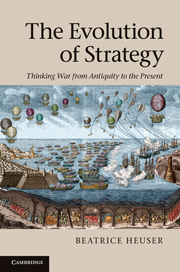Book contents
- Frontmatter
- Contents
- Acknowledgements
- A note on referencing
- Part I Introduction
- PART II Long-term constants
- PART III The Napoleonic paradigm and Total War
- PART IV Naval and maritime Strategy
- 8 Long-term trends and early maritime Strategy
- 9 The age of steam to the First World War
- 10 The World Wars and their lessons for maritime Strategists
- 11 Maritime Strategies in the nuclear age
- PART V Air Power and nuclear Strategy
- PART VI Asymmetric or ‘small’ wars
- PART VII The quest for new paradigms after the World Wars
- Bibliography
- Index
8 - Long-term trends and early maritime Strategy
from PART IV - Naval and maritime Strategy
Published online by Cambridge University Press: 05 June 2012
- Frontmatter
- Contents
- Acknowledgements
- A note on referencing
- Part I Introduction
- PART II Long-term constants
- PART III The Napoleonic paradigm and Total War
- PART IV Naval and maritime Strategy
- 8 Long-term trends and early maritime Strategy
- 9 The age of steam to the First World War
- 10 The World Wars and their lessons for maritime Strategists
- 11 Maritime Strategies in the nuclear age
- PART V Air Power and nuclear Strategy
- PART VI Asymmetric or ‘small’ wars
- PART VII The quest for new paradigms after the World Wars
- Bibliography
- Index
Summary
The rule of the sea is indeed a great matter.
(Pericles, q.i. Thucydides I.143, 20)Those nations and cities that have the command of the sea, even if they are foiled on land, they can never be thoroughly vanquished, before they are beaten from the sea.
(Matthew Sutcliffe 1593: 273)Strategy on land, at sea and in the air
Terminology for land warfare and sea warfare is partly different. Where we talk of Strategy, Tactics, sometimes of operational art, with relation to the sea, it has been within the wider context of ‘command of the sea’ or ‘seapower’, a term traced to Thucydides’ ‘rule of the sea’ (Starr 1978). Admiral Sir Herbert Richmond, who upon retiring from the Royal Navy became a Cambridge don, defined it thus just after the Second World War:
Sea power is that form of national strength which enables its possessor to send his armies and commerce across stretches of sea and ocean which lie between his country or the country of his allies, and those territories to which he needs access in war; and to prevent his enemy from doing the same. (Richmond 1947: ix)
The term ‘strategy’ appeared even later in a naval context than in Western writing on war in general. An entirely unsurprising definition in the Clausewitzian and Jominian tradition (see chapter 1) is that of Giovanni Sechi in his Elementi di arte militare marittima of 1906:
The conduct of naval warfare belongs to naval strategy; the execution of the strategic concepts is attributed to logistics if one is not in the presence of the enemy, to tactics when the cannon thunders … Consequently, we can say that strategy is the spirit which thinks, logistics and tactics are the arms [brazzi] that act. (q.i. Castex 1937: 6)
Here, as in general definitions of Strategy, much value was added by bringing in the political dimension. Sir Julian Corbett very helpfully introduced ‘maritime strategy’ as a generic term which subsumes the narrower concept of ‘naval strategy’ for the use of force at sea. Taking a wider, holistic perspective on Strategy, Corbett understood that ‘maritime strategy’ necessarily had to involve land warfare, but might – and in the case of island states like Great Britain usually did – involve the use of navies. If both land and naval warfare were involved, Corbett recommended the use of the term ‘maritime strategy’, with the purely sea-bound element of this Strategy being naval warfare:
By maritime strategy we mean the principles which govern a war in which the sea is a substantial factor. Naval strategy is but that part of it which determines the movements of the fleet when maritime strategy has determined what part the fleet must play in relation to the action of the land forces … it is almost impossible that a war can be decided by naval action alone.
On their own, navies could but exhaust the enemy, and would simultaneously exhaust themselves. For a ‘firm decision’, co-operation of land and naval forces was required.
Since men live upon the land and not upon the sea, great issues between nations at war have always been decided – except in the rarest cases – either by what your army can do against your enemy’s territory and national life or else by the fear of what the fleet makes it possible for your army to do.
- Type
- Chapter
- Information
- The Evolution of StrategyThinking War from Antiquity to the Present, pp. 201 - 215Publisher: Cambridge University PressPrint publication year: 2010



